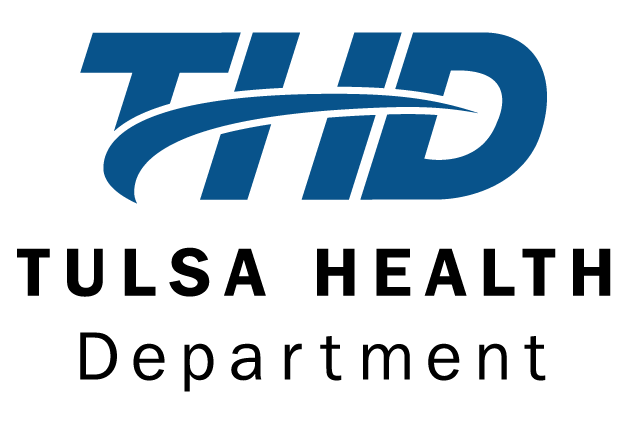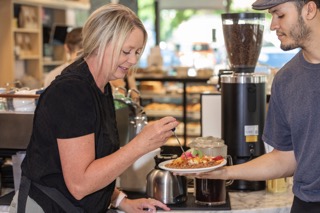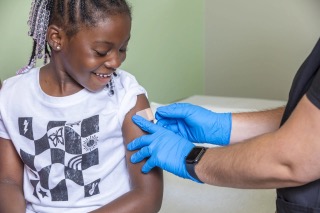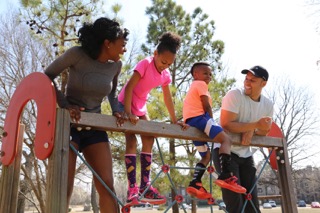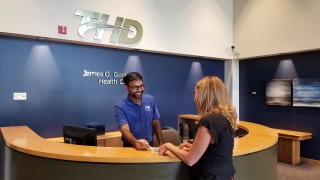Almost 16 months ago, the Tulsa Health Department (THD) stood up its Incident Command Structure (ICS) due to the first case of COVID-19 in Tulsa County.
At some point throughout this response, everyone at THD has had some sort of role within this operation to protect the residents of Tulsa County. Whether it was through information sharing, via the phone bank or even discussions with friends/neighbors, disease investigation, testing or providing vaccines, their hard work is appreciated.
“Along with my current program responsibilities, I had to add the responsibilities of responding to a pandemic,” said Kelly VanBuskirk, Division Chief, Prevention, Preparedness and Response and COVID-19 Incident Commander. “This provided its own challenges to navigate through since we have not had a pandemic of this magnitude.”
VanBuskirk was hired at THD in early 2002 in the Emergency Preparedness and Response program (EPRP). Over the course of many years, she has worked as a Health Planner, EPRP Planner and an Epidemiologist before becoming a Division Chief.
“While working at THD, I achieved getting a Master’s in Public Health degree and have attended multiple trainings to better understand public health and serving the community and overall population health needs,” she said. “In my day to day job at THD, I oversee five programs with amazing staff.”
The programs she manages include Epidemiology, Emergency Preparedness and Response, Healthy Living Program, Regional Prevention Coordinator Program and Tulsa Fetal/Infant Mortality Review Program.
As incident commander of a response, she had to understand the type and severity of an incident and continually monitor the situation. She had to assign command structure roles (command and general staff) as it relates to the operations, logistics, communications (PIO), finance, planning and safety to support the response. All of these roles are identified as Section Chiefs and are assigned to individuals within the health department. She coordinated the activities of the command and general staff that includes but is not limited to: providing the team with daily situational awareness, along with local and State partners and working closely with the agency administrator, determining operational periods, identifying incident objectives and ensure they are being met, approve all messaging and releases, approve requests for resources and work with community partners. And if that sounds like a lot, it is – on top of all of her normal duties.
“The biggest challenge, especially in the beginning, is that information and recommendations were changing fast,” she expressed. “As soon as information was shared it would change because this was a new virus and we were learning new things every day and that caused trust concerns because it would change all the time so quickly.”
The lesson she learned from this was to always be transparent. While recommendations were not always popular, she remained transparent with them as her team were always looking out for the health and safety of the community we serve. Another challenge faced was securing resources, whether it was testing supplies in the beginning, PPE for staff or vaccines when it came time to begin administering vaccines. Overall, as a team, she admits everyone learned that when we work together and support one another, everything will work out.
“Our community and our staff are resilient,” she said. “It was a scary virus spreading across our nation and our world. From a work perspective, not only were we dealing with it while trying to protect the community, we were also all dealing with it on a personal level, trying to keep our families and our friends safe. I think we were challenged on many levels both professionally and personally, as we all know someone who was affected by this virus whether it was illness or loss of life. We continued to show up, we continued to do our jobs. It showed us how strong we are as a team, as a community and as individuals.”
VanBuskirk also expressed the great work people see on the front lines of the response is only half of the response. She understands that this great work doesn’t come with all the behind-the-scenes planning and commitment.
“People do not realize there is another half of the response that is occurring behind the scenes (and honestly all the planning that occurs throughout the years for responses),” she added. “The work behind the scenes and the decisions being made helped drive and support this response and others. The individuals behind the scenes should be recognized for the exceptional work that they did, day in and day out to make this response a success.”
While COVID-19 is still in the community, THD has seen the demand for vaccine and testing decrease along with calls for information, therefore as of June 21, 2021, THD is no longer operating under ICS. All operations of the response have been incorporated into day-to-day activities at THD and will continue to provide services as it relates to COVID-19 but in a different capacity which is outlined below.
Communications – Marketing and Creative Services will continue to provide information to the public via multiple outlets to ensure the public and partners continue to have situational awareness of COVID information.
THD Phone Bank – The phone bank will remain operational and has expanded to not only include COVID-19 information but also back to school immunizations information and other information as needed.
COVID-19 Testing – Swab POD Operations are no longer occurring at THD as they are now partnering with Access Medical Clinics and Tulsa Mobile COVID Testing, utilizing funding from a grant to continue to refer individuals to free COVID-19 testing.
COVID-19 Vaccine Administration – COVID vaccines will still be provided to the public through clinical operations at four THD main sites: James O. Goodwin, Central Regional Health Center, North Regional Health & Wellness Center and Sand Springs Health Center.
Epi Investigations/Contact Tracing – Disease investigations continues with positive COVID-19 cases and monitoring of variants.
THD continues to encourage individuals to get vaccinated, stay home when ill and work to slow the spread. Public health professionals do not know what may or may not happen in the fall/winter months, so while THD demobilizes the response, there is capacity to remobilize an operation should it be warranted.
During the approximately 470 days since THD identified the first case in Tulsa County and stood up ICS, demobilized and stood down ICS, THD has:
Collected over 24,600 samples for COVID testing through our Swab POD
Answered over 103,000 phone calls through the THD phone bank
Investigated thousands and thousands of cases and epi links to cases
Administered over 130,000 vaccines at our COVAX POD and THD clinics
Conducted well over 1,000 media interviews locally, nationally and even internationally
Developed a very detailed, interoperable data dashboard
Formed many new partnerships with local, state and federal partners, especially the National Guard
“Thank you to our staff, our community partners and volunteers for all you have done to support this operation and continued efforts in the days ahead,” said VanBuskirk.
